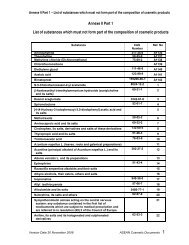Pollution from Personal Actions, Activities, and Behaviors - US ...
Pollution from Personal Actions, Activities, and Behaviors - US ...
Pollution from Personal Actions, Activities, and Behaviors - US ...
You also want an ePaper? Increase the reach of your titles
YUMPU automatically turns print PDFs into web optimized ePapers that Google loves.
‡Biological Effects of Low Level Exposure - BELLE<br />
Hormesis: Major aspect of BELLE (http://www.belleonline.com/)<br />
Paradoxical or unanticipated effect at low doses of a chemical<br />
Hypothetical, paradoxical phenomenon of seemingly beneficial effects at low doses for chemicals<br />
that are otherwise toxic at higher doses<br />
Hormetic: Substance that presents an adverse risk at higher exposure levels but serves to protect at<br />
lower exposure levels<br />
Protection purportedly afforded by a variety of mechanisms including: adaptation, damage repair,<br />
<strong>and</strong> stimulation of biochemical processes (e.g., efflux pumps)<br />
In contraposition to the traditional linear/log-linear low-dose extrapolation model<br />
Scientifically controversial (e.g., U- <strong>and</strong> inverted U-shaped curves)<br />
< More focus should be applied to the realm of subtle effects [see hypothesis proposed by Daughton <strong>and</strong><br />
Ternes in “Pharmaceuticals <strong>and</strong> <strong>Personal</strong> Care Products in the Environment: Agents of Subtle<br />
Change” Environ. Health Perspect. 1999, 107(suppl 6), 907-938]<br />
< The question exists as to whether immediate biological actions on non-target species can be<br />
imperceptible but nonetheless lead to adverse impacts as a result of continual accretion over<br />
long periods of time. For example – latent damage, only surfacing later in life. Could subtle effects<br />
accumulate so slowly (perhaps seeming to be part of natural variation) that major outward change<br />
cannot be ascribed to the original cause Effects that are sufficiently subtle that they are undetectable<br />
or unnoticed present a challenge to risk assessment (especially ecological) — e.g., subtle shifts in<br />
behavior or intelligence. Subtle effects can be slow but still lead to significant change – analogous to<br />
aging (with its associated degeneration of biological functions), not noticed on a daily or weekly or<br />
even yearly basis, but profoundly obvious over the longer term<br />
< Must separately consider each class of drugs having distinct MOAs. There are many discrete classes of<br />
PPCPs, each with distinct modes of action: e.g., antibiotics, efflux pump inhibitors, sex steroids,<br />
SSRIs, etc.<br />
< With respect to human exposure, intake of multiple drugs adds to the complexity of additional burden<br />
to patients already taking medications having low therapeutic indexes (e.g., combined loading of<br />
individual anticholinergics or serotonin modulators)<br />
< Concerns regarding at-risk populations (e.g., compromised health, fetuses, children).<br />
REMEDIATION/TREATMENT/POLLUTION PREVENTION: If PPCPs eventually prove to be an<br />
environmental concern, it is unknown whether sewage treatment facilities could be cost-effectively<br />
modified to reduce emissions. <strong>Pollution</strong> prevention is preferable to remediation (proactive vs. reactive<br />
approaches). Some near-term actions to consider for minimizing the introduction of PPCPs to the<br />
environment or their potential effects:<br />
< Environmental “Friendliness”: Factor environmental proclivity into PPCP design/marketing “green”<br />
PPCPs: maximize biodegradability/photolability to innocuous end products, minimize therapeutic<br />
dose (“calibrated dosing”), more single-enantiomer drugs<br />
< Develop alternative, optimal delivery mechanisms: Reduce dosages with (1) new routes for existing<br />
<strong>and</strong> new drugs (e.g., inhalable, dermal), (2) new formulations (e.g., for insoluble drugs - ca. 30% of<br />
prepared by C.G. Daughton, Ph.D. page 8 of 13<br />
U.S. EPA, ORD/NERL, Las Vegas, NV 18 February 2001





![View Clearinghouse copy of document [PDF]](https://img.yumpu.com/9233544/1/190x245/view-clearinghouse-copy-of-document-pdf.jpg?quality=85)